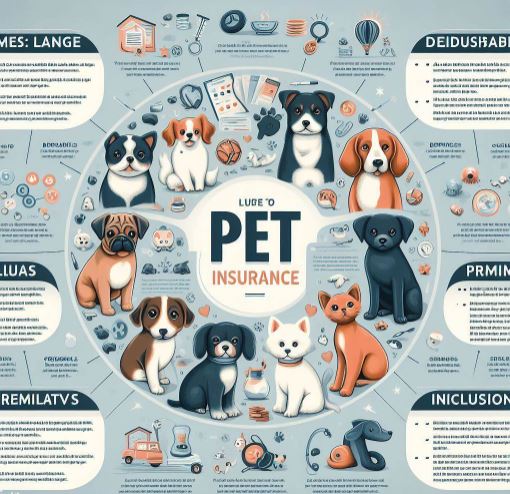When selecting pet insurance, it’s crucial to opt for a plan that suits your needs. Explore the primary types of pet insurance in this article.
Pet insurance serves as a valuable tool for pet owners aiming to mitigate risks and manage their budget while safeguarding their furry companions’ well-being.
However, comprehending how pet insurance operates and the various coverage options can pose a challenge. Not to worry – understanding it is more straightforward than it seems!
This article will introduce you to the four main categories of pet insurance and offer guidance on choosing a plan that aligns with your preferences.

Lifetime Pet Insurance
Lifetime pet insurance plans, known for their popularity, provide extensive coverage for your pet. Typically encompassing both accidents and illnesses, these plans renew annually, covering your pet’s health as long as you renew the policy.
Lifetime plans are more likely to include coverage for pre-existing conditions. Given their comprehensive nature, these plans tend to be more expensive. As the name suggests, you can make claims at any point in your pet’s life, adhering to the plan’s terms and limits.
Coverage of Lifetime Pet Insurance
- Veterinary treatment for illnesses and injuries
- Lifelong or chronic conditions
- Death, loss, or theft of your pet
- Dental injury or illness
- Third-party liability (dogs)
Suitable Candidates for Lifetime Pet Insurance
- Seek the best possible coverage for their pet
- Own a young dog or cat and wish to ensure coverage throughout their life
- Have a pet with a long-term illness or condition
- Can afford a higher premium
Types of Lifetime Pet Insurance Plans: Different types include annual lifetime insurance policies with a yearly coverage cap and per-condition plans with limits on payments for each condition within a specified timeframe. The higher the payout limits, the more expensive the plan tends to be.
Overall, lifetime pet insurance policies are an excellent choice for those who prioritize comprehensive coverage and can afford it.
Maximum Benefit Pet Insurance
Maximum benefit pet insurance offers coverage up to a predetermined monetary amount for any injury or illness. You can make multiple claims until reaching the maximum benefit, with no time limit. However, once the maximum benefit is reached, any additional treatment expenses must be covered out of pocket.
Coverage of Maximum Benefit Pet Insurance:
- Veterinary expenses for illness and injury up to a certain limit
- Death, loss, or theft of your pet
- Dental injury or illness
- Third-party liability (dogs)
Suitable Candidates for Maximum Benefit Pet Insurance: Ideal for those who:
- Want to cover vet expenses for accidents or short-term illnesses
- Can afford additional expenses out of pocket after reaching the maximum benefit
While not as comprehensive as lifetime pet insurance, maximum benefit policies still offer substantial coverage.
Time-Limited Pet Insurance
Time-limited pet insurance provides coverage up to a specified amount within a limited timeframe, typically 12 months. After this period, any additional treatment costs are the responsibility of the pet owner. These policies are generally more affordable and cover both accidents and illnesses.
Coverage of Time-Limited Pet Insurance:
- Vet expenses for illnesses and injuries
- Death, euthanasia
- Loss or theft
- Third-party liability (dogs)
Suitable Candidates for Time-Limited Pet Insurance: Ideal for those seeking an affordable way to cover short-term illnesses and injuries.
Accident-Only Pet Insurance
This type of pet insurance focuses solely on accident-related expenses up to a fixed amount. It covers injuries resulting from a single incident, such as a bone fracture, and may include emergency treatment for illness in some policies. While it has lower monthly costs, it does not cover illnesses. Accident-only coverage is often the only option available for senior pets.
Coverage of Accident-Only Pet Insurance:
- Accidental injuries from a single incident
- Some policies may include emergency treatment for illness
Suitable Candidates for Accident-Only Pet Insurance: Ideal for those who
- Have a young, healthy pet less likely to need veterinary care
- Have a pet more prone to accidents than illnesses
- Have an older pet ineligible for other coverage due to age limits
Some accident-only pet insurance policies may have time limitations, requiring policy renewal for continued coverage against accidents.
Considerations When Choosing Pet Insurance
- Your pet’s age: Insure your pet from a young age, as insurance tends to become more expensive as pets age.
- Your pet’s breed: Some providers may restrict coverage for certain breeds or charge more for pedigree pets.
- Pre-existing conditions: Insuring your pet from a young age is advisable, as most plans do not cover pre-existing conditions.
- Type and number of pets: The type and number of pets influence plan costs, with dogs generally more expensive to insure than cats.
- Desired coverage: Choose from accident-only, accident and illness coverage, or comprehensive coverage including wellness.
- Budget: Consider your monthly premium affordability and potential out-of-pocket expenses for unexpected vet fees.
- Additional benefits: Compare policies for perks such as member discounts, live chat, vet video calls, etc.
- Waiting periods: Be aware of waiting periods before coverage begins, especially if your pet requires urgent treatment.
While pet insurance is invaluable for covering unexpected veterinary costs, proactive measures such as using the Tractive GPS Dog & Cat Tracker & Wellness Monitor can enhance your pet’s safety and health.
Attach the lightweight device to your pet’s collar or harness to track their movements, monitor activity and sleep, set up Virtual Fences, view Location History, and share their location with friends and family.
This proactive approach complements the benefits of pet insurance, ensuring comprehensive care for your beloved pet.